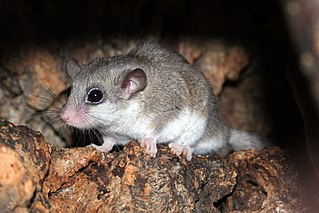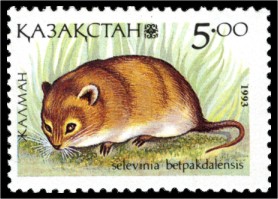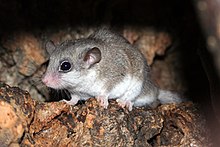
The Europeanedible dormouse or European fat dormouse is a large dormouse and one of only two living species in the genus Glis, found in most of Europe and parts of western Asia. The common name comes from the Romans, who ate them as a delicacy.

The hazel dormouse or common dormouse is a small dormouse species native to Europe and the only living species in the genus Muscardinus.

The African dormice are dormice that live throughout sub-Saharan Africa in a variety of habitats. They are very agile climbers and have bushy tails. They eat invertebrates and small vertebrates.
The Lorrain dormouse is a species of rodent in the family Gliridae. It is found in Cameroon, Democratic Republic of the Congo, Ghana, Guinea-Bissau, Liberia, Nigeria, Sierra Leone, Tanzania, and Uganda. Its natural habitats are subtropical or tropical, moist, lowland forests, moist savanna, and plantations.

The desert dormouse is a species of rodent in the dormouse family, Gliridae. This species was formerly placed in its own family, Seleviniidae, but it is now considered to be a dormouse, monotypic within the genus Selevinia. It is endemic to Kazakhstan.

Leithiinae is a subfamily of dormice. It is named after the Leithia, an extinct genus of giant dormouse from the Pleistocene of Sicily.

The forest dormouse is a species of rodent in the family Gliridae found in eastern Europe, the Balkans and parts of western Central Asia. It is categorized as being of least concern in the IUCN List of Threatened Species due to its wide range and stable population trend. Forest dormice have a diploid count (2n) of 48 chromosomes. Even though this species lives in a variety of geographic locations, its greatest population density is in the forests of central Moldova, in Transcaucasia, and in the mountains of Central Asia. In most other locations, population density of this species is rather low. Population density is dependent on many factors. But the main features that this species depends on for choosing a location are the presence of the appropriate food sources as well as good foliage that can be used for a habitat. The reason why the forests in central Moldova have the highest population density is they provide the largest diversity of food sources which are available throughout the year. This location also provides the best type of foliage for the forest dormice to build their nests as well as swing from branches. The combination of both of these aspects allows for this species to have its highest needs met. Therefore, during mating season they produce offspring who also stay in the same general area when they mature. It makes sense not to move from an area if it is providing for your most basic needs.

Hypnomys, otherwise known as Balearic giant dormice, is an extinct genus of dormouse (Gliridae) in the subfamily Leithiinae. Its species are considered examples of insular gigantism. They were endemic to the Balearic Islands in the western Mediterranean from the Early Pliocene until their extinction around 4,000 years ago. They first appeared in the fossil record on Mallorca during the Early Pliocene, presumably due to the Messinian salinity crisis causing a connection with mainland Europe. They later spread to Menorca, and a possible molar is also known from Ibiza. Hypnomys became extinct during the Holocene after human arrival on the Balearics. They were one of only three native land mammals to the islands at the time of human arrival, alongside the shrew Nesiotites and goat-antelope Myotragus.
Walter Verheyen's African dormouse is a monotypic species of rodent in the family Gliridae. From the Central Congolian lowland forests ecoregion in the central Congo Basin, it has been found in west-central Democratic Republic of the Congo, in the vicinity of the Lukenie River and of Wafania, near the left bank of the Luilaka River. Although not found in immediate association, Lorraine's dormouse and the short-eared African dormouse are understood to be "broadly sympatric". Most closely resembling Jentink's dormouse, it differs from this species both in its much smaller size and in its relative proportions. On the IUCN Red List, its conservation status has been assessed as Data Deficient.








